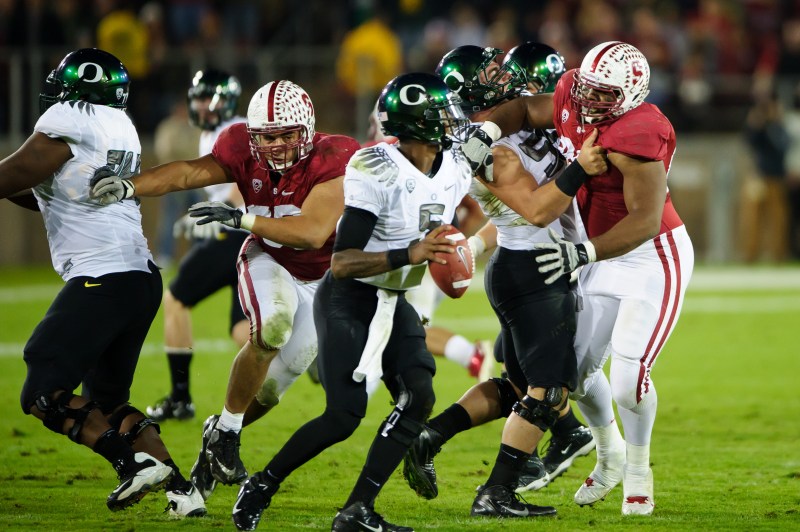It’s been four days since Stanford’s 56-48 overtime escape against Arizona, and there’s one statistic that I’m still struggling to wrap my head around: 491 yards.
That’s the number of yards that the Cardinal defense gave up through the air to the Wildcats last Saturday afternoon.
Yes, Matt Scott is one of the top three quarterbacks in the Pac-12. Yes, the course of Saturday’s game resulted in an inevitable offensive explosion. But 491 yards? That seeems almost inexplicable considering that Stanford held Matt Barkley, who is still the projected first pick of the 2013 NFL Draft despite recently taking a backseat to West Virginia’s Geno Smith in the Hesiman race, to 254 passing yards.
I’m hesitant to say that the reason is because the Stanford defense played poorly. Neither the front seven nor the secondary was on its A-game, but there has to be a better explanation when a defense that has given up 14 points per game suddenly lets 48 points go up on the board.
Whether Stanford fans like it or not, there’s a simple truth behind the 491 passing yards and 46 points that the team allowed. It’s not that the Cardinal doesn’t know how to stop the spread offense, it’s that the Cardinal physically cannot stop an elite spread offense.
I emphasize “elite” because no medicore, wishy-washy spread offense can beat the Cardinal. It takes the likes of Oregon and Airzona to give Stanford real trouble. Credit is given where credit is due; if nothing else, Rich Rodriguez knows how to implement the spread offense successfully.
When it comes to playing against pro-style offenses, I would pick Stanford’s front seven over any other group except for maybe Alabama’s NFL-caliber corps. But the one thing that the Cardinal defenders have consistently sruggled with in recent years is running from sideline to sideline and making touchdown-saving open-field tackles to contain a spread offense.
The major reason? Stanford’s defense lacks pure speed. Make no mistake, guys like Chase Thomas, Shayne Skov and Ben Gardner are as explosive as any other defender in college football. But when some of the fastest running backs and wide receivers in the nation make you first run ten yards horizontally with them before you can even come up to make the stop, it’s bound to wear you down and cause you to miss a few tackles. And a few missed tackles lead to game-changing touchdowns in the blink of an eye.
One of the best examples of this can be seen in the games that Stanford has played against Oregon in the last two years. When the Cardinal defense has faced speed demons in the likes of LaMichael James, Kenjon Barner and De’Anthony Thomas, who all have unofficial “40” times under 4.40, the end results have been disastrous.
The only way that Stanford could stop Oregon’s running back was to stop the halfbacks right at the line of scrimmage, which the Cardinal managed to do in the first couple drives. But once the backs got past the front seven and into the second level as the game progressed, it ended up turning into an episode of “Tom and Jerry.” Simply put, there was just nothing the Stanford defenders could do to stop the bleeding.
When the Cardinal and the Ducks met in 2010, James exploded for 257 yards on the ground. Last year’s meeting between the two teams had a similar result, as Oregon averaged five yards per carry to beat Stanford 53-30 and end its national title hopes. With Barner and Thomas leading Oregon’s rushing attack this year, it seems almost inevitable that the Cardinal defense will once again give up a boatload of points when it travels to Autzen in just over a month.
Every defense has a kryptonite. For USC, it’s the screen game and Lane Kiffin’s stupidity. For Arizona, it’s the big offensive linemen that bulldoze their way across the field so that their team can inflict 182 yards of damage on the ground that the Wildcats give up per game.
And for Stanford, it just happends to be the well-executed spread offense.
George Chen once completed the 40 in just over 4.2 seconds in high school. His joy knew no bounds, until the official scorer let him know that Wheelie shoes were not allowed. Commiserate with George and discuss the event that forever changed his football career at [email protected].
